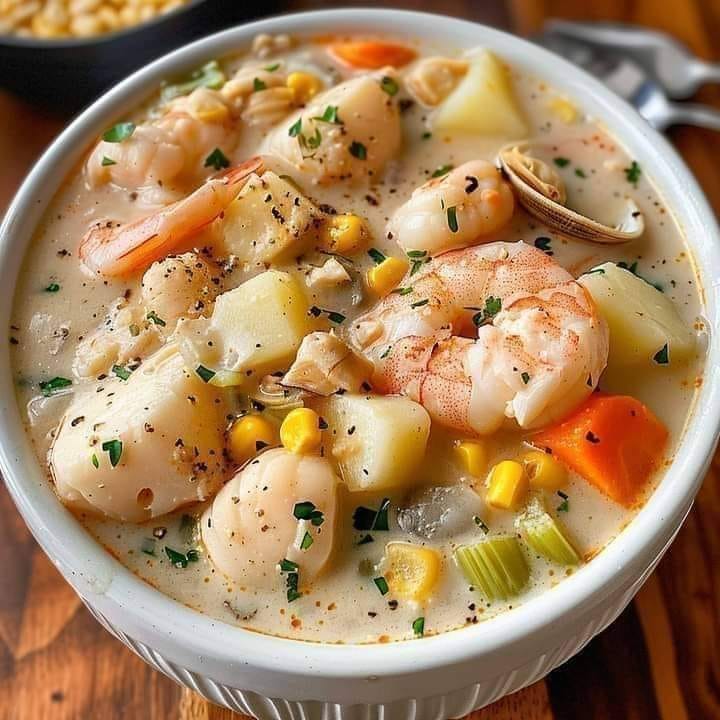- Render the Bacon
In a large Dutch oven or heavy-bottomed pot, cook the diced bacon over medium heat until it’s crisp. Remove the bacon with a slotted spoon and set it aside, leaving the rendered bacon fat in the pot. - Sauté the Vegetables
Add the diced onion to the pot with the bacon fat, sautéing for 3-4 minutes until it becomes translucent. Add the carrots and celery, and cook for another 5 minutes until softened. Add the minced garlic and cook for 1 minute more, until fragrant.
Step 2: Building the Broth
- Add Potatoes and Seasonings
Stir in the diced potato, and pour in the seafood or chicken stock and water. Add the bay leaf, thyme, Old Bay seasoning, and a pinch of salt and pepper. - Simmer
Bring the soup to a boil, then reduce the heat to low and cover. Simmer for 15-20 minutes, or until the potatoes are tender and cooked through. The starch from the potatoes will help thicken the chowder.
Step 3: Adding the Cream and Seafood
- Add Cream and Milk
Pour in the heavy cream and milk, stirring to blend. Bring the mixture back to a gentle simmer without boiling. - Add the Fish and Shrimp
Gently add the white fish and shrimp to the chowder. Let them cook for 3-5 minutes until they are opaque and cooked through. - Add Mussels or Clams
Finally, add the mussels or clams, covering the pot and allowing them to cook for 3-5 minutes, or until the shells have opened. Discard any mussels or clams that don’t open. - Adjust Seasoning
Taste the chowder and adjust the salt, pepper, or Old Bay seasoning if needed. If you like a thicker chowder, you can mash some of the potatoes against the side of the pot to create a creamier consistency.
Step 4: Garnishing and Serving
- Serve with Bacon and Parsley
Ladle the chowder into bowls, garnishing each with the crispy bacon bits and a sprinkle of fresh parsley. For extra brightness, add a squeeze of fresh lemon juice to each bowl. - Optional Sides
Serve with crusty bread or oyster crackers to soak up the creamy broth. A side of lemon wedges will also enhance the fresh seafood flavors.
Tips for Making the Best Seafood Chowder
- Use Fresh Seafood: Fresh seafood gives the chowder its best flavor. If fresh isn’t available, frozen seafood is a good alternative, but be sure to thaw it thoroughly.
- Avoid Overcooking the Seafood: Overcooked seafood can become rubbery, so add it near the end of the cooking process and watch closely.
- Layer the Flavors: Sautéing the bacon and vegetables adds a depth of flavor to the broth. Don’t rush this step, as it will make the chowder richer and more delicious.
- Choose Your Seafood: This recipe is versatile; you can swap or add in your favorite seafood like scallops, crab meat, or even lobster for a special touch.
- Make it Your Own: For added texture, you can include corn or diced bell peppers. Or for a smoky touch, add a pinch of smoked paprika to complement the bacon.
Storage Tips
- Refrigerate: Store any leftover chowder in an airtight container in the refrigerator for up to 2 days. Seafood chowder tastes even better the next day as the flavors meld, but it’s best to consume it within a day or two for the freshest taste.
- Reheat Gently: Reheat over low heat on the stovetop, stirring occasionally to prevent the cream from separating.
Final Thoughts
This Seafood Chowder is a cozy, indulgent dish that brings a taste of the coast to your table. With layers of flavor and textures from fresh seafood, creamy broth, and smoky bacon, it’s a bowl of comfort that’s both elegant and satisfying. Enjoy this heartwarming chowder with loved ones, and let it transport you to a seaside getaway in every spoonful!
